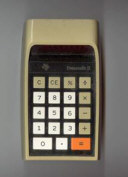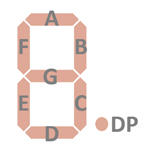
DATAMATH CALCULATOR MUSEUM
 |
DATAMATH CALCULATOR MUSEUM |
Texas Instruments announced on September 17, 1971 with the TMS1802NC the first available standard calculator building block on a chip, it was later renamed into TMS0102. The chip integrates 3,520 Bits Read-Only program Memory (ROM, 320 Words x 11 Bits), a 182-bit Serial-Access Memory (SAM, 3 Registers * 13 Digits, 2 * 13 Bit-Flags) and a decimal arithmetic logic unit as well as control, timing, and output decoders but no drivers for the display. These function blocks of the chip add up to an overall complexity of roughly 5,000 transistors.
While the TMS0100 product family was an impressive achievement combining the electronics of two Integrated Circuits (ICs) housed in large 40-pin packages into a single IC with a much smaller 28-pin package, could Texas Instruments advertisement "calculator-on-a-chip" be misleading. The Bill of Materials (BOM) of a typical calculator based on the TMS0100 design like the TI-2500 Datamath included not only the calculator chip, housing, keyboard assembly, display assembly, rechargeable batteries and a power [ON-OFF] switch, we did count on the printed circuit board (PCB) of the already cost-optimized TI-2500B introduced in January 1974 a myriad of components:
|
TMS0119 Calculator Chip 2 SN75494 Digit Driver Chips 2 SN27915 Segment Driver Chips 5 Transistors 12 Diodes 1 Inductor 20 Resistors 7 Capacitors |
Consequently the suggested retail price of the TI-2500B was marked with an astonishing $69.95, about $349 in 2000s money and more than $500 in 2020s money!
Texas Instruments was able to significantly drop the manufacturing costs of the Datamath with the introduction of the TI-2500 II in November 1974 based on the TMS0800 Chip with the integration of both the segment drivers and clock oscillator into a small 28-pin package.
Credits for the first "real" single-chip calculator circuit operated by a 9-Volt battery go to the TMS0950 Chip introduced early in 1975 based on the TMS1000, the Worlds first Microcomputer. While switching from the chip-size efficient Register Processor architecture of the TMS0100 design to a more flexible Digit Processor architecture of the TMS1000, more than doubling the program memory from 3,520 Bits to 8,192 Bits, increasing the data memory from 182 Bits to 256 Bits resulting in an overall complexity of about 8,000 transistors, could the BOM of a typical electronic handheld calculator be reduced dramatically due to a series of measures:
|
Integration of both segment and digit drivers for a 9-digit LED display Lowering the two supply voltages from -10.0V and -15.8V to a single supply voltage of -9V provided by a disposable alkaline battery Integration of clock circuitry and power-on reset circuitry |
Due to a smart pin-out of the 28-pin package matching both the pin-out of the display assembly and keyboard assembly and the use of only 6 discrete components (4 resistors, 1 capacitor and [ON-OFF] switch) avoiding any cross-points in the layout of the circuit, the whole electronics of a calculator could be placed easily on a simple, single-sided PCB. One side effect of integrating additional functionality to the specifications of the TMS1000 while keeping the pin-count limited to 28 was a reduction of the number of digit outputs from 11 to 9.
The TI-1200 was introduced in March 1975 with a MSRP of $24.95, ditching the rather expensive Klixon keyboard and paving the way to the sub-$10 calculator leading to casualties like Bowmar Industries in 1976 during the Calculator War.
Texas Instruments even further optimized the design of the TMS0950 with the introduction of the pin-compatible TMS0970 in March 1976 and avoiding any passive components other than the [ON-OFF] switch on the PCB.
Due to its short product cycle of just one year only three calculators are based on the original TMS0950 design, while the TMS0970 later renamed to TMC0970 and TMC0900 - could be considered one of the most successful calculator chip designs next to the TMC0980.
QUICK-LINK to Calculator Circuits with LED Direct-Drive.
| Type | Calculators | Keyboard | Digits | Fixed DP | Special Functions |
(6,7,9) Font |
Entry Overflow |
Calculating Overflow |
Memory Indicator |
| TMS0952 | TI-1200, TI-1250 | [+][-][=] | sign + 8 | F | [Memory][%] | ||||
| TMS0954 | TI-1260 | [+][-][=] | sign + 8 | F | [Memory][%] [Conversions] |
||||
| TMS0956 | Sharp EL-204 | [+][-][=] | sign + 8 | F | [Memory][%] [√x] |
| Description | Comments | |
| Architecture | Single-chip Calculator | Basic |
| Category | Digit Processor | 4-bit Digits |
| Related |
TMS1000 Portfolio TMS0970 |
Improved design |
| ROM Size | 8,192 Bits | 1024 Words * 8 Bits |
| RAM Size | 256 Bits | 64 Digits |
| Outputs | 9 Digits 8 Segments |
Internal Digit Drivers Internal Segment Drivers |
| Inputs | 4 Keyboard 1 Oscillator Mode 1 Reset |
Segments to Keyboard Scan-Matrix |
The Datamath Calculator Museum DCM-50A (Platform) supports the TMS0950 Product Family with the TMS0900 Adapter plugged into the right-most TMS1000 Textool Test Socket set to DCM-50A (TMS0900) mode. Both Characterization of TMS0950 Calculator Circuits and Reverse-engineering of TMS0950 Calculator Circuits is supported by the DCM-50A (TMS0900).
| Item | Min | Typ | Max | Unit | Comments |
| VSS | 0 | V | |||
| VDD | -9.0 | V | |||
| CK | 180 | kHz | Rext= 68k Ohm, Cext= 68 pF |
The TMS0950 was manufactured in a 8.0 um metal gate PMOS process (metal width = 0.30 mil / 8.0 um, metal spacing = 0.35 mil / 9.0 um, diffusion width = 0.25 mil / 6.0 um, diffusion spacing = 0.30 mil / 8.0 um).
The die size of the TMS0950 is approximately 200 mils * 210 mils / 5.2 mm * 5.3 mm.
The TMS0950 uses either a 0.6 wide 28-pin DIP (Plastic Dual In-line Package with a 0.1 / 2.54 mm lead pitch)
or a 0.4 wide 28-pin SPDIP (Shrink Plastic Dual In-line Package with a 0.07 / 1.778 mm lead pitch).
| Pin | IO | Function | Pin | IO | Function |
| 1 | O | Digit driver 7 | 28 | O | Digit driver 6 |
| 2 | O | Digit driver 8 (MSD) | 27 | O | Digit driver 5 |
| 3 | O | Digit driver 9 (sign) | 26 | O | Digit driver 4 |
| 4 | V | Negative Voltage VDD | 25 | O | Digit driver 3 |
| 5 | I | Keymatrix input 1 | 24 | O | Digit driver 2 |
| 6 | I | Keymatrix input 2 | 23 | O | Digit driver 1 (LSD) |
| 7 | I | Keymatrix input 4 | 22 | R | 6k8 to VDD |
| 8 | I | Keymatrix input 8 | 21 | V | Reference voltage |
| 9 | I | Key or power on reset | 20 | V | Common Voltage |
| 10 | O | Segment driver DP | 19 | I | OSC2 (Ext. CLK = VSS) |
| 11 | O | Segment driver G | 18 | I | OSC1 (Cext, Rext) or Ext |
| 12 | O | Segment driver F | 17 | O | Segment driver A |
| 13 | O | Segment driver E | 16 | O | Segment driver B |
| 14 | O | Segment driver D | 15 | O | Segment driver C |
| The Segment drivers A-G and DP (Decimal Point) are connected to the display in the pictured way. |  |
The keyboards of all calculators based on the TMS0950 Product Family consist of an x/y-matrix connected to six or seven segment-driver outputs and the keymatrix inputs K1 to K4. The Power-on reset is usually not connected to a key.
Example for the TI-1250 with TMS0952:
| K1 | K2 | K4 | K8 | |
| O7 (Seg. DP) | MC | MR | M− | M+ |
| O6 (Seg. G) | ||||
| O5 (Seg. F) | C | +/− | % | ÷ |
| O4 (Seg. E) | 7 | 8 | 9 | × |
| O3 (Seg. D) | 4 | 5 | 6 | − |
| O2 (Seg. C) | 1 | 2 | 3 | + |
| O1 (Seg. B) | CE | 0 | . | = |
| O0 (Seg. A) |
Example for the Sharp EL-204 with TMS0956:
| K1 | K2 | K4 | K8 | |
| O7 (Seg. DP) | CM | RM | M− | M+ |
| O6 (Seg. G) | ||||
| O5 (Seg. F) | C | % | √x | ÷ |
| O4 (Seg. E) | 7 | 8 | 9 | × |
| O3 (Seg. D) | 4 | 5 | 6 | − |
| O2 (Seg. C) | 1 | 2 | 3 | + |
| O1 (Seg. B) | CE | 0 | . | = |
| O0 (Seg. A) | +/− |
Calculators based on the TMS0950 make use of 9-digit LED (Light-Emitting-Diode) Displays with common cathode architecture. The TI-1200/TI-1250 uses the LED-stick DIS233.
If you have additions to the above datasheet please email: joerg@datamath.org.
© Joerg Woerner, February 02, 2001. No reprints
without written permission.